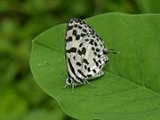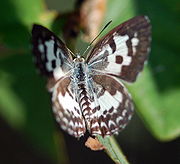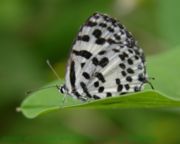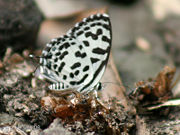
Castalius rosimon
Encyclopedia
The Common Pierrot is a small butterfly
found in India
that belongs to the Lycaenids or Blues
family.
. India, Myanmar
; Tenasserim, extending into the Malayan Subregion. In the Indonesian archipelago the butterfly occurs in NE Sumatra
, East Java
, Bali
, Bangka
, Timor
, Wetar
, Kissar
, Sumbawa
and Sulawesi
.
In India the butterfly is found in peninsular India
south of the outer ranges of the Himalayas
, except in desert tracts; East India
; the North West Himalayas
; Assam
. The butterfly is also found in the Andaman Islands
and South Nicobar Islands
.
_on_mikania_micrantha_(bittervine,_chinese_creeper)_at_narendrapur_w_img_4203.jpg) Upperside is mainly white. Forewing has the costa, apex and termen edged with black, the edging much broader on apex and termen; base outwards for a short distance more or less densely overlaid. with metallic blue scales which cover and make indistinct a large basal outwardly clavate black spot; a transverse black oval spot on the discocellulars touching the black edging on the costa ; an oblique irregular line of four quadrate black spots beyond, the upper spot coalesced with the black on the costal border, the next spot below shifted outwards out of line, touching, as does also the lowest spot, the terminal black edging; posterior to this is a quadrate black spot in the apical half of interspace 2, and placed obliquely outwards from 1b coalescent with the terminal black border, another similar spot in interspace 1.
Upperside is mainly white. Forewing has the costa, apex and termen edged with black, the edging much broader on apex and termen; base outwards for a short distance more or less densely overlaid. with metallic blue scales which cover and make indistinct a large basal outwardly clavate black spot; a transverse black oval spot on the discocellulars touching the black edging on the costa ; an oblique irregular line of four quadrate black spots beyond, the upper spot coalesced with the black on the costal border, the next spot below shifted outwards out of line, touching, as does also the lowest spot, the terminal black edging; posterior to this is a quadrate black spot in the apical half of interspace 2, and placed obliquely outwards from 1b coalescent with the terminal black border, another similar spot in interspace 1.

Hind wing: three basal black somewhat coalescent spots overlaid with metallic blue scaling; the costal margin above the subcostal vein and vein 7 black; this colour filling also the base of interspace 6, where in some specimens it is divided into a basal portion with a spot beyond; a postdiscal curved transverse black band followed by a subterminal transverse series of black spots, each spot edged inwardly and outwardly by very slender lunules of the white ground-colour; on the inner side of the postdiscal band posteriorly is a broken line of four black generally coalescent spots two and two, the two upper often touching the postdiscal band.
_at_narendrapur_w_img_4218.jpg) Underside primarily white. Fore wing has a long oblique black band from base outwards to the costa; below it and obliquely placed an irregular black somewhat conical mark; following these are two outwardly oblique, medially interrupted, black macular bands; the inner of the two extended from costa along the discocellulars, is then widely interrupted below its posterior portion that is formed of two elongate coalescent spots and touches the inner subterminal transverse line of elongate spots just above the tornus; the outer, obliquely placed line is subapical and medially broken, the middle portion consisting of a quadrate spot is shifted outwards; finally, two parallel sub-terminal transverse series of black elongate spots, the inner series of broad, more or less rectangular spots, the outer series of more linear spots, the latter coalescent anteriorly with a slender ante-ciliary black line.
Underside primarily white. Fore wing has a long oblique black band from base outwards to the costa; below it and obliquely placed an irregular black somewhat conical mark; following these are two outwardly oblique, medially interrupted, black macular bands; the inner of the two extended from costa along the discocellulars, is then widely interrupted below its posterior portion that is formed of two elongate coalescent spots and touches the inner subterminal transverse line of elongate spots just above the tornus; the outer, obliquely placed line is subapical and medially broken, the middle portion consisting of a quadrate spot is shifted outwards; finally, two parallel sub-terminal transverse series of black elongate spots, the inner series of broad, more or less rectangular spots, the outer series of more linear spots, the latter coalescent anteriorly with a slender ante-ciliary black line.

Hind wing: a transverse basal black band, with an elongate black spot below it on the dorsum; a transverse sub-basal line of four well-separated black spots; a transverse, oval, disco-cellular black spot and obliquely above it three subcostal similar spots, the inner two coalescent; postdiscal and terminal markings consist, the former of four black posterior spots two
and two, each pair coalescent and placed en echelon, the latter of a transverse double series of subterminal black spots and an anticiliary black line; the upper portion of the postdiscal markings touches the inner subterminal line. Cilia of both fore and hind wings white alternated with black at the apices of the veins ; filamentous short tail to the hind wing black tipped with white.
Antennae, head, thorax and abdomen black, the shafts of the antennae ringed with white, the head between the eyes and behind them white; beneath: the palpi, thorax and abdomen white, the last barred broadly with white on the sides.
 Similar to the male but with the black markings on the upper and under sides broader.
Similar to the male but with the black markings on the upper and under sides broader.
and Aitken
)
form but narrow and slightly flattened. It is intensely glossy as if covered with gum. It varies in colour, being sometimes black, at others green with inconstant black markings." (Davidson, Bell & Aitken)
Butterfly
A butterfly is a mainly day-flying insect of the order Lepidoptera, which includes the butterflies and moths. Like other holometabolous insects, the butterfly's life cycle consists of four parts: egg, larva, pupa and adult. Most species are diurnal. Butterflies have large, often brightly coloured...
found in India
India
India , officially the Republic of India , is a country in South Asia. It is the seventh-largest country by geographical area, the second-most populous country with over 1.2 billion people, and the most populous democracy in the world...
that belongs to the Lycaenids or Blues
Lycaenidae
The Lycaenidae are the second-largest family of butterflies, with about 6000 species worldwide, whose members are also called gossamer-winged butterflies...
family.
Distribution
Sri LankaSri Lanka
Sri Lanka, officially the Democratic Socialist Republic of Sri Lanka is a country off the southern coast of the Indian subcontinent. Known until 1972 as Ceylon , Sri Lanka is an island surrounded by the Indian Ocean, the Gulf of Mannar and the Palk Strait, and lies in the vicinity of India and the...
. India, Myanmar
Myanmar
Burma , officially the Republic of the Union of Myanmar , is a country in Southeast Asia. Burma is bordered by China on the northeast, Laos on the east, Thailand on the southeast, Bangladesh on the west, India on the northwest, the Bay of Bengal to the southwest, and the Andaman Sea on the south....
; Tenasserim, extending into the Malayan Subregion. In the Indonesian archipelago the butterfly occurs in NE Sumatra
Sumatra
Sumatra is an island in western Indonesia, westernmost of the Sunda Islands. It is the largest island entirely in Indonesia , and the sixth largest island in the world at 473,481 km2 with a population of 50,365,538...
, East Java
Java
Java is an island of Indonesia. With a population of 135 million , it is the world's most populous island, and one of the most densely populated regions in the world. It is home to 60% of Indonesia's population. The Indonesian capital city, Jakarta, is in west Java...
, Bali
Bali
Bali is an Indonesian island located in the westernmost end of the Lesser Sunda Islands, lying between Java to the west and Lombok to the east...
, Bangka
Bangka
Bangka can refer to:* Bangka Island, an island of Indonesia* Bangka Regency, Indonesia* Bangka Strait, a strait of Indonesia* Bangka language, spoken in Indonesia* Tagalog: bangka, an outrigger canoe* Wanhua District, Taipei City...
, Timor
Timor
Timor is an island at the southern end of Maritime Southeast Asia, north of the Timor Sea. It is divided between the independent state of East Timor, and West Timor, belonging to the Indonesian province of East Nusa Tenggara. The island's surface is 30,777 square kilometres...
, Wetar
Wetar
The tropical island of Wetar belongs to the Indonesian province of Maluku and is the largest island of the Barat Daya Islands . It lies east of the Lesser Sunda Islands, which include nearby Alor and Timor, but it is politically part of the Maluku Islands...
, Kissar
Kissar
The kissar , or Gytarah barbaryeh, the ancient Nubian lyre, still in use in Egypt and Abyssinia . It consists of a body having instead of the traditional tortoise-shell back, a shallow, round bowl of wood, covered with a soundboard of sheepskin, in which are three small round sound-holes...
, Sumbawa
Sumbawa
Sumbawa is an Indonesian island, located in the middle of the Lesser Sunda Islands chain, with Lombok to the west, Flores to the east, and Sumba further to the southeast. It is in the province of West Nusa Tenggara....
and Sulawesi
Sulawesi
Sulawesi is one of the four larger Sunda Islands of Indonesia and is situated between Borneo and the Maluku Islands. In Indonesia, only Sumatra, Borneo, and Papua are larger in territory, and only Java and Sumatra have larger Indonesian populations.- Etymology :The Portuguese were the first to...
.
In India the butterfly is found in peninsular India
India
India , officially the Republic of India , is a country in South Asia. It is the seventh-largest country by geographical area, the second-most populous country with over 1.2 billion people, and the most populous democracy in the world...
south of the outer ranges of the Himalayas
Himalayas
The Himalaya Range or Himalaya Mountains Sanskrit: Devanagari: हिमालय, literally "abode of snow"), usually called the Himalayas or Himalaya for short, is a mountain range in Asia, separating the Indian subcontinent from the Tibetan Plateau...
, except in desert tracts; East India
India
India , officially the Republic of India , is a country in South Asia. It is the seventh-largest country by geographical area, the second-most populous country with over 1.2 billion people, and the most populous democracy in the world...
; the North West Himalayas
Himalayas
The Himalaya Range or Himalaya Mountains Sanskrit: Devanagari: हिमालय, literally "abode of snow"), usually called the Himalayas or Himalaya for short, is a mountain range in Asia, separating the Indian subcontinent from the Tibetan Plateau...
; Assam
Assam
Assam , also, rarely, Assam Valley and formerly the Assam Province , is a northeastern state of India and is one of the most culturally and geographically distinct regions of the country...
. The butterfly is also found in the Andaman Islands
Andaman Islands
The Andaman Islands are a group of Indian Ocean archipelagic islands in the Bay of Bengal between India to the west, and Burma , to the north and east...
and South Nicobar Islands
Nicobar Islands
The Nicobar Islands are an archipelagic island chain in the eastern Indian Ocean...
.
Male
_on_mikania_micrantha_(bittervine,_chinese_creeper)_at_narendrapur_w_img_4203.jpg)

Hind wing: three basal black somewhat coalescent spots overlaid with metallic blue scaling; the costal margin above the subcostal vein and vein 7 black; this colour filling also the base of interspace 6, where in some specimens it is divided into a basal portion with a spot beyond; a postdiscal curved transverse black band followed by a subterminal transverse series of black spots, each spot edged inwardly and outwardly by very slender lunules of the white ground-colour; on the inner side of the postdiscal band posteriorly is a broken line of four black generally coalescent spots two and two, the two upper often touching the postdiscal band.
_at_narendrapur_w_img_4218.jpg)

Hind wing: a transverse basal black band, with an elongate black spot below it on the dorsum; a transverse sub-basal line of four well-separated black spots; a transverse, oval, disco-cellular black spot and obliquely above it three subcostal similar spots, the inner two coalescent; postdiscal and terminal markings consist, the former of four black posterior spots two
and two, each pair coalescent and placed en echelon, the latter of a transverse double series of subterminal black spots and an anticiliary black line; the upper portion of the postdiscal markings touches the inner subterminal line. Cilia of both fore and hind wings white alternated with black at the apices of the veins ; filamentous short tail to the hind wing black tipped with white.
Antennae, head, thorax and abdomen black, the shafts of the antennae ringed with white, the head between the eyes and behind them white; beneath: the palpi, thorax and abdomen white, the last barred broadly with white on the sides.
Female

Larva
"Feeds on Zizyphus jujuba and is of a rough texture as if shagreened all over. It is of the usual woodlouse form, much flattened towards the anal segment which is very broad; head concealed; colour bright green with a double, dorsal, yellow line and the sides powdered with small yellow spots." (Davidson, BellThomas Reid Davys Bell
Thomas Reid Davys Bell , born in Bandon, Cork, was a lepidopterist and forest officer in India.Thomas was the youngest in a family of twelve. His early education was in Dresden. He tried to get into the Indian Civil Services but failed. He later wrote entrance exams to Sandhurst and Woolwich,...
and Aitken
Edward Hamilton Aitken
Edward Hamilton Aitken was a civil servant in India, better known for his humorist writings on natural history in India and as a founding member of the Bombay Natural History Society...
)
Pupa
"Of the usual CastaliusCastalius
Castalius is a butterfly genus in the family Lycaenidae. They are commonly known as pierrots. This name is also often used for the very closely related genus Tarucus....
form but narrow and slightly flattened. It is intensely glossy as if covered with gum. It varies in colour, being sometimes black, at others green with inconstant black markings." (Davidson, Bell & Aitken)
External links
- Asahi Correctly determined photos of Castalius rosimon specimens.
See also
- LycaenidaeLycaenidaeThe Lycaenidae are the second-largest family of butterflies, with about 6000 species worldwide, whose members are also called gossamer-winged butterflies...
- List of butterflies of India
- List of butterflies of India (Lycaenidae)

